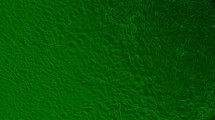Summary
This study reports for the first time the establishment of immortalized cell lines from normal adult rat parotid glands. The freshly prepared cellular clumps obtained from parotid glands of isoproterenol-treated rats were incubated in 0.2% trypsin solution without EDTA. These clumps were transfected with plasmid vectors pSV neo3 and pSV neo5 by electroporation and calcium phosphate-Co-DNA-precipitation techniques. The untransfected and transfected cellular clumps were plated in precoated dishes containing modified MCDB-153 medium. Epithelial cells grew from the clumps that were attached. All epithelial cells from untransfected culture died within 6 to 8 wk. Two cell lines which were isolated from transfected cultures subsequently grew on regular tissue culture dishes. One of them, which was isolated from pSV neo5 transfected cultures, exhibited non-epithelial cell morphology, but at confluency, many cells mature to acinar-like cells containing numerous granules. The other cell line (2RS), which was isolated from pSV neo3 transfected culture, contained cells of non-epithelial and epithelial morphology. During the initial phase of the growth, MCDB-153 medium was essential; however, at a later time, RPMI medium was better than MCDB-153 or F12 medium for maintaining morphology and growth of these cells. The immortalized cells grew in RPMI with a doubling time of about 25 h, synthesize T-antigen,α-amylase mRNAs of 1176 and 702 bp, andα-amylase and were non-tumorigenic. These amylase-producing cells can be a useful model to study the mechanisms of regulation of growth and differentiation in these cells.
Similar content being viewed by others
References
Barka, T. Induced cell proliferation. The effect of isoperternol. Exp. Cell Res. 37:662–679; 1965.
Chomezymski, P.; Sacchi, N. Simple step method of RNA isolation by acid guanidiumthiocyanate-phenol-chloroform extractions. Anal. Biochem. 162:156–159; 1987.
Chopra, D. P.; Xue-Hu, I. Secretion ofα-amylase in human parotid gland epithelial cell culture. J. Cell. Physiol. 155:223–233; 1993.
Gorman, G. High efficiency gene transfer into mammalian cells. In: Glover, D. M., ed. DNA cloning, vol. 2. Washington, D.C.: IRL Press; 1985:149–190.
Lechner, J. G.; LaVeek, M. A. A serum free method for culturing normal human bronchial cells at clonal density. J. Tissue Cult. Methods 9:43–48; 1985.
Pirisi, L.; Yasumoto, S.; Feller, M., et al. Transformation of human fibroblasts and keratinocytes with papilloma virus type 16 DNA. J. Virol. 61:1061–1066; 1987.
Prasad, K. N.; Edwards-Prasad, J.; Carvalho, E., et al. Establishment of primary cultures of rat and human parotid epithelial cells for transfection experiments. In Vitro Cell. Dev. Biol. 28A:493–499; 1992.
Prasad, K. N.; Carvalho, E.; Edwards-Prasad, J., et al. Establishment of human pleomorphic adenoma cells in culture: morphological and biochemical characterization. In Vitro Cell. Dev. Biol. in press; 1994.
Sabitini, L. M.; Allen-Hoffmann, B. L.; Warner, T. F., et al. Serial cultivation of epithelial cells from human and macaque salivary glands. In Vitro Cell. Dev. Biol. 27A:939–948; 1991.
Schneyer, C. A. Salivary gland changes after isoproterenol induced enlargement. Am. J. Physiol. 203:232–236; 1992.
Sambrook, J.; Fritisch, E. F.; Maniatis, T. Molecular cloning: a laboratory manual, 2nd ed. Cold Spring Harbor, NY: Cold Spring Harbor Laboratory, 1989.
Southern, P. J.; Berg, P. Transformation of mammalian cells to antibiotic resistance with a bacterial gene under control of SV40 early region promotor. J. Mol. Appl. Genet. 1:327–341; 1982.
Tur-Kaspa, R.; Teichner, L.; Levine, B. J., et al. Use of electroporation to introduce biologically active foreign genes into rat primary hepatocytes. Mol. Cell. Biol. 6:716–718; 1986.
Yeh, C. K.; Mertz, P. M.; Oliver, C., et al. Cellular characteristics of long-term culture rat parotid acinar cells. In Vitro Cell. Dev. Biol. 27A:707–712; 1991.
Author information
Authors and Affiliations
Rights and permissions
About this article
Cite this article
Prasad, K.N., Carvalho, E., Edwards-Prasad, J. et al. Establishment and characterization of immortalized cell lines from rat parotid glands. In Vitro Cell Dev Biol - Animal 30, 321–328 (1994). https://doi.org/10.1007/BF02631453
Received:
Accepted:
Issue Date:
DOI: https://doi.org/10.1007/BF02631453




